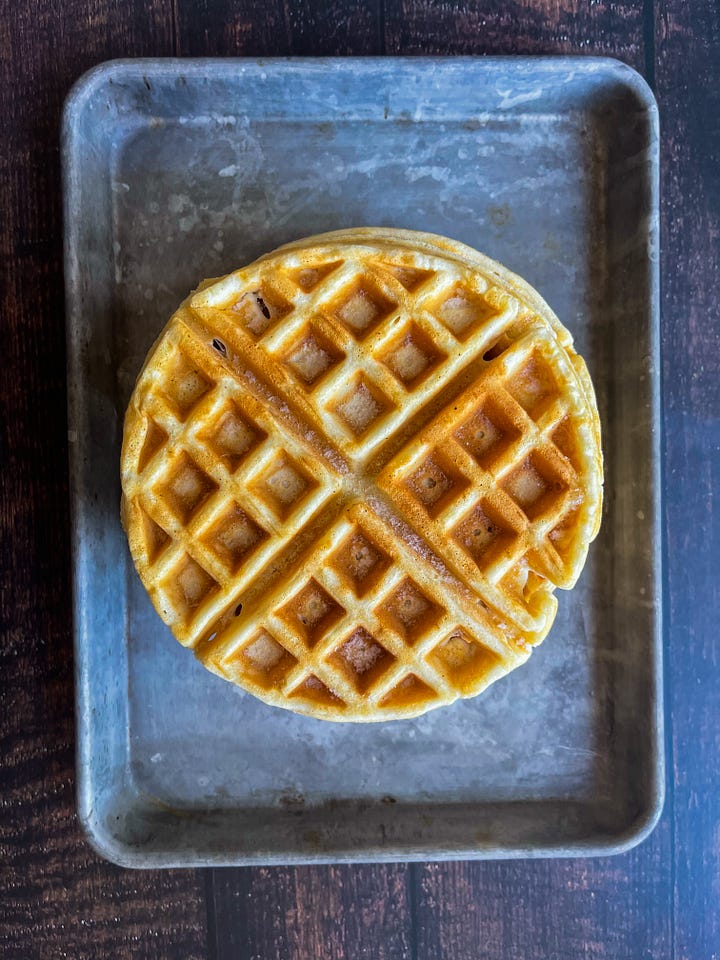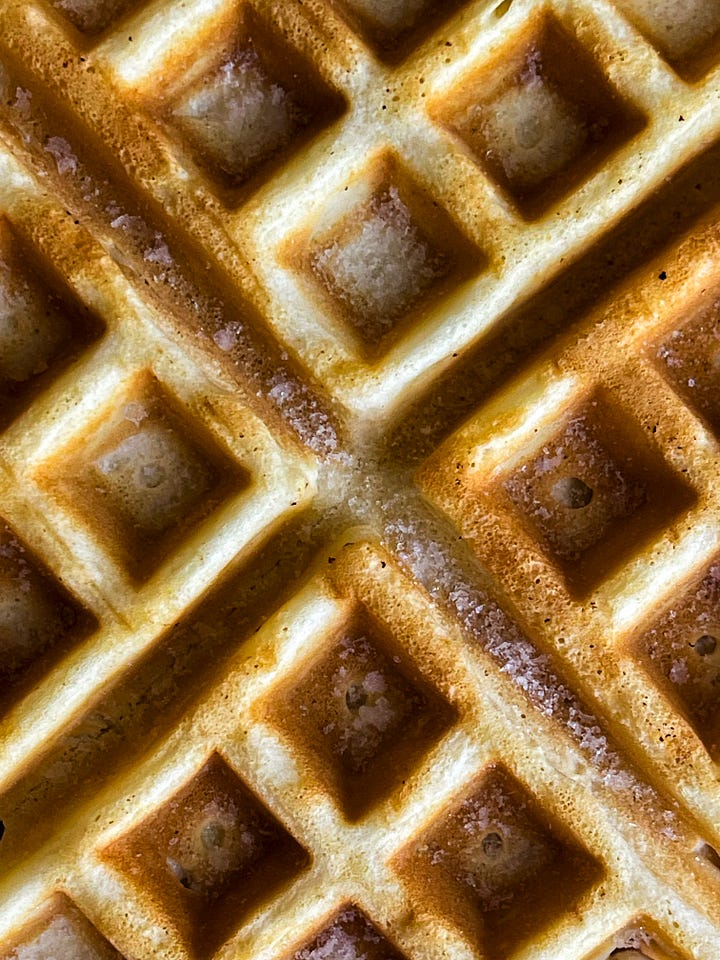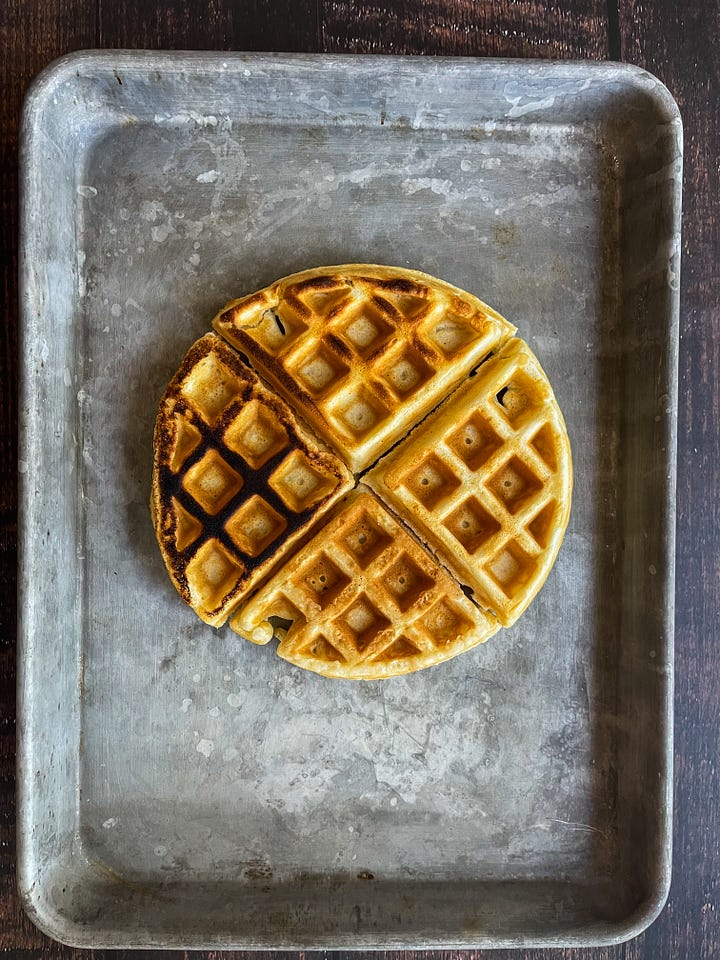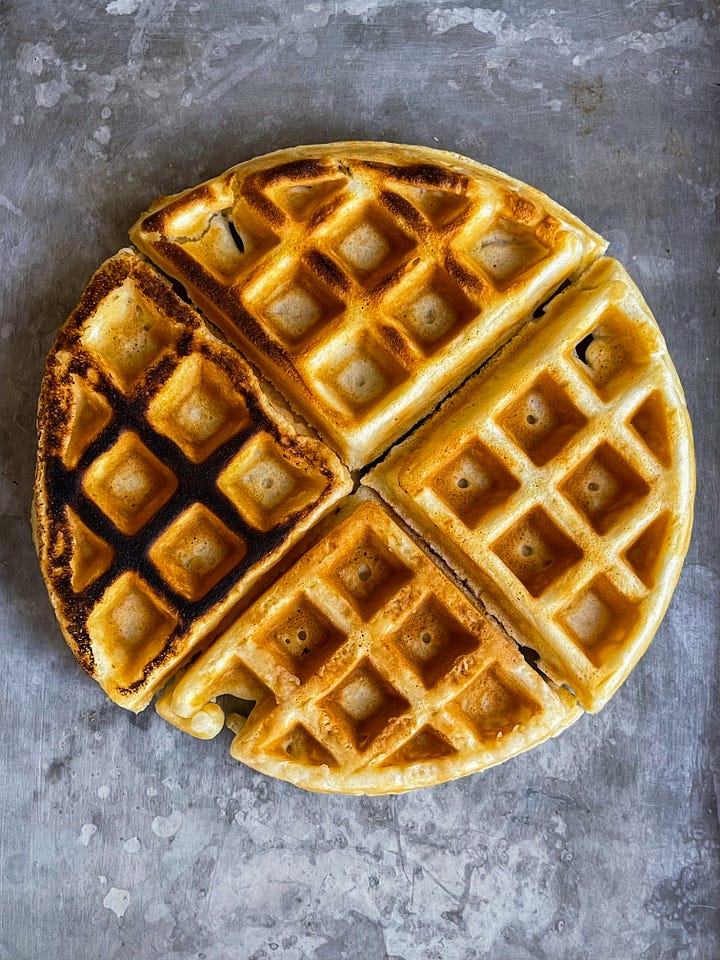Freezing the Leftovers
When freezing leftover waffles, I follow a couple of principles:
I allow the the leftovers to sit out at room temperature for at least a half hour, on a drying rack. I do this because I want them to cool down completely, specifically so that they stop steaming. If you added a still-hot waffle to, say, a resealable plastic bag, and put it in the freezer, that steam the steam that is still escaping from the waffle is captured in the bag, and it turns into ice, and eventually ice crystals, which then lead more into freezer burn, and culminate in wasted effort).
If I have a bunch of waffles leftover (i.e., I literally just made an extra batch of waffles to freeze), I break them apart into their quadrants. I primarily do this because, when I have a lot of them to freeze, they fit into bags better. Truth be told, my daughter is the usual consumer of these reheated waffles, and she’s only going to eat a half of a waffle, at most. While it is handy to have them all broken up ahead of time, that’s not really that much of a benefit, because once they’re frozen, they’re usually quite brittle and easy to break into their quadrants anyway. What I typically don’t do is stack a bunch of whole waffles directly on top of one another (like you’d make a stack of pancakes), because they always seem to freeze together for me, and then I have to pry them apart when I only really need one or two quadrants.


Outside of that, just make sure they’re going into a sealable container or bag when you’re freezing them. Don’t force or smash them into a container, because they’ll lose their shape and look sad when you reheat them (I mean, this is a personal preference thing… they’ll still be delicious, you’ll just be eating a smashed waffle).
I have reheated waffles from my recipes that have been frozen for as much as three months, and they still came out great. I do recommend caution with this, however, as the longer you leave anything in the freezer, the more likely it is to start absorbing that weird, freezer burned taste, and the tastes of anything that might be frozen next it it.
Reheating Waffles
There is a reason that you find scores of toaster waffles in the freezer isle of your grocery store, but you don’t see microwave waffles.
Because microwaving waffles is wrong. Not quite a crime but inching close to it.
Toasters have heating coils that run through their sides, which sandwich your food in the middle and heat it by way of the heat radiating off the coils. To put it plainly, those coils heat the food between them from the outside in.
Microwaves cook foods by sending waves of energy through foods, which cause the water molecules in the food to agitate, generating heat. They heat the food in them from the inside out.
Why does one work, and the other doesn’t?
The answer stems from the desired texture of waffles. They’re meant to be crisp or crunchy on the outside, while remaining soft, fluffy, and airy on the inside. Breaking that down to its most basic principles, the outside of the waffle is crisp and dry, and the inside is fluffy and moist.
When you microwave a waffle, the moisture from the inside turns into steam and heats the waffle while that steam escapes. What you end up with is a waffle that’s squishy on the outside, and dry and chewy on the inside. In other words, a sad, overcooked shell of its former self.
The big problem, though, is that not only do full, regular-sized waffles not fit in a toaster, they’re also just a completely different animal from a purpose-built toaster waffle. Regular waffles are so thick that, even at the lowest heat settings, toasters produce burnt spots. The waffle is simply too wide, and its sides come too close to the toaster’s internal heating coils.
So how should you reheat your waffle?
Well, first of all, if you have a toaster oven and you’re only reheating one waffle, that’s a solution. Similarly, if you bought into the air fryer hype, you could set that to toast, or to 275-325 and reheat a waffle in there for around five minutes. The most basic solution if you don’t have either of those is to put the waffles you’re reheating into the oven, straight on the rack, turn your oven on to 275, and set a timer for 8-10 minutes. For many people, that’s about the amount of time it takes for the oven to finish preheating, but after the timer goes off, check the waffle to make sure it’s cooked through completely, and serve it immediately. This method has the added benefit allowing you to reheat many waffles at once, and as I have previously mentioned, I’m a big fan of serving everyone at once.
Fair warning, you’ll find that reheating waffles in an oven will yield good results as long as you have your timing down, but the timing can be unforgiving. The difference between perfectly reheated and over-toasted can be a matter of a minute in a half.
As a quick visual representation of how different each of these methods can be, here’s a shot of one waffle, with each of its quadrants separated and cooked in these methods:


Keep in mind, the point of all of this is to do it straight from frozen, because although a waffle would only take about 20-30 minutes to defrost completely at room temperature (they should be very airy and light, so there shouldn’t be a lot of moisture in them in the first place), I try to be as realistic as possible about things. I have a toddler at home, and I am fully aware that every second matters when it comes to preparing food, especially given that the alternative that stares everyone in the face in the frozen food isle at the grocery store actually does reheat in five minutes in the toaster, and it’s got cartoons on the box.
The top quadrant (11-1 o’clock) is the toaster, which was set to a heat setting of 1 out of 5, and had to be pushed down twice just to get it heated all the way through. You can see that by the time the center of the waffle was hot, parts of the outside was overcooked. You can also clearly see the bits of the waffle that were just too close to the heating coils.
The second quadrant (2-4 o’clock) is the waffle that went into the oven at 275. It was in for a total of nine minutes, because for me that’s how long it takes my oven to reach that temp, and I have done this so many times I know that the waffle is done. This is my method of choice, because I know when I hear my oven chime that it’s done preheating, the waffles are ready. Appearance-wise, you’ll note that it’s also the least dark of the lot. its exterior is crunchy, and the interior is still fluffy and moist. If I had left it in another minute, I know (again, from experience) that it would've gotten much darker, and much crunchier and more dry.
The third quadrant (5-7 o’clock) is the microwave. Now, this one’s hard to fully wrap your head around from the photo, because just judging by the appearance, it looks like it’s fine. Let me tell you, it had the density and rigidity of an unsellable dog treat. This went into the microwave for a total of 1 1/2 minutes at 50% power. It came out somewhat spongey on the outside, and if you look really closely, you can see that some of the top of the waffle flattened as it steamed itself in the microwave. But man, 30 seconds after being out of the microwave, this thing shriveled up into a piece of raw hide.
The fourth quadrant (8-10 o’clock). Yeah. That one’s burnt. For the sake of science and everyone’s education, I thought I’d try something here. There’s been a movement recently to get folks to stop reheating leftover pizza in the microwave, and instead to have them heat it in a pan. The method that is typically outlined borrows heavily from how one would cook potstickers, in that you heat up a pan over medium-low heat with a small amount of oil, which cooks the bottom of the slice to a crisp as the pan gets warm. Once the pan is hot, you add a tablespoon or so of water, and put a lid on the pan, allowing it to steam the top of the slice (in this case, waffle). Once the water has evaporated away, the lid of the pan is removed, and you’re good to go. As you can see, this does not work with waffles. My thinking with this was that, as the biggest battle you fight with reheating something that is frozen is retaining moisture without losing texture, this method may keep the outside crisp, while steaming it to keep it moist and fluffy. I was wrong. In retrospect, I probably would’ve seen a better result just putting a waffle in on low heat, placing a lid on top, and cooking it for somewhere between 5-10 minutes, but in that case, wouldn’t you be just as well off putting it in the oven?


